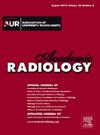Exploratory Development of a Prognostic Model for Coronary Artery Disease Utilizing CT-FFR Derived Functional Duke Jeopardy Score
IF 3.8
2区 医学
Q1 RADIOLOGY, NUCLEAR MEDICINE & MEDICAL IMAGING
引用次数: 0
Abstract
Rationale and Objectives
To explore the prognostic value of the functional Duke Jeopardy Score based on CT-FFR(fDJSCTA) in assessing major adverse cardiovascular events (MACE) in patients with coronary artery disease (CAD).
Materials and Methods
A total of 894 patients with stable CAD with stenosis ranging from 30% to 90%, who underwent CCTA were included in the study. Follow-up was performed to record MACE. The patients were randomly divided into training and validation sets in a 7:3 ratio. In the training set, prognostic analysis was performed and predictive model was constructed using univariable and multivariable Cox regressions and compared the area under the receiver operating characteristic curve (AUC), net reclassification improvement (NRI) and integrated discrimination improvement (IDI) of different indicators. The receiver operating characteristic curve, calibration curve and clinical decision curve were used to evaluate the model's discrimination, calibration and clinical efficacy.
Results
The median follow-up period was 33 (16–36) months, during which 167 cases (18.68%) of MACE occurred. Males accounted for 61.52% (550/894) of the cohort, with a median age of 61.92 years. The multivariate Cox regression analysis indicated that DJSCTA (HR: 2.07, 95% CI: 1.17 ∼ 3.68) and fDJSCTA (HR: 4.68, 95% CI: 2.97 ∼ 7.38) were independent predictors of MACE. Using MACE as a standard, fDJSCTA improved the risk re-stratification ability of CT-FFR (NRI:0.993, P < 0.001) and the predictive ability of CT-FFR (IDI:0.101, P < 0.001) and DJSCTA (IDI:0.079, P < 0.001). The prediction model demonstrated high discrimination (training AUC: 0.84 [0.80–0.89]; validation AUC: 0.82 [0.75–0.89]), good calibration and clinical efficacy.
Conclusion
The fDJSCTA was the strongest predictor of MACE. The model constructed based on fDJSCTA has certain clinical utility in prognostic evaluation for CAD.
利用CT-FFR衍生功能杜克危险评分的冠状动脉疾病预后模型的探索性发展
理由与目的:探讨基于CT-FFR(fDJSCTA)的功能性Duke Jeopardy Score在评估冠心病(CAD)患者主要不良心血管事件(MACE)中的预后价值。材料与方法:894例狭窄程度在30% ~ 90%的稳定期冠心病患者行CCTA。随访记录MACE。患者按7:3的比例随机分为训练组和验证组。在训练集中,采用单变量和多变量Cox回归进行预后分析,构建预测模型,比较不同指标的受试者工作特征曲线下面积(AUC)、净重分类改善(NRI)和综合判别改善(IDI)。采用受试者工作特征曲线、校正曲线和临床决策曲线评价模型的鉴别性、校正性和临床疗效。结果:中位随访时间为33(16-36)个月,期间发生MACE 167例(18.68%)。男性占61.52%(550/894),中位年龄为61.92岁。多因素Cox回归分析表明,DJSCTA (HR: 2.07, 95% CI: 1.17 ~ 3.68)和fDJSCTA (HR: 4.68, 95% CI: 2.97 ~ 7.38)是MACE的独立预测因子。以MACE为标准,fDJSCTA可提高CT-FFR的风险再分层能力(NRI:0.993, P - CTA (IDI:0.079, P)结论:fDJSCTA是MACE的最强预测因子。基于fDJSCTA构建的模型在CAD预后评价中具有一定的临床应用价值。
本文章由计算机程序翻译,如有差异,请以英文原文为准。
求助全文
约1分钟内获得全文
求助全文
来源期刊

Academic Radiology
医学-核医学
CiteScore
7.60
自引率
10.40%
发文量
432
审稿时长
18 days
期刊介绍:
Academic Radiology publishes original reports of clinical and laboratory investigations in diagnostic imaging, the diagnostic use of radioactive isotopes, computed tomography, positron emission tomography, magnetic resonance imaging, ultrasound, digital subtraction angiography, image-guided interventions and related techniques. It also includes brief technical reports describing original observations, techniques, and instrumental developments; state-of-the-art reports on clinical issues, new technology and other topics of current medical importance; meta-analyses; scientific studies and opinions on radiologic education; and letters to the Editor.
 求助内容:
求助内容: 应助结果提醒方式:
应助结果提醒方式:


